
Silvics of North America (1991), a forest inventory compiled and published by the United States Forest Service, includes many hardwood trees. It superseded Silvics of Forest Trees of the United States (1965), which was the first extensive American tree inventory. A variety of statistics on all of these trees are maintained by the National Plant Data Team of the US Department of Agriculture.
Hardwood from North American trees has a variety of commercial uses, including in furniture, carpentry, tools and musical instruments. Some timber is milled for plywood, wood veneer and construction framing, including structural support beams and studs. Logs can be fashioned into posts and poles. Less sturdy timber is often ground and processed into pulpwood, principally for papermaking. Resins from sap yield wood tar, turpentine or other terpenes. Some resins and other tree products contain dangerous toxins (not generally listed below). Much of the economic value of trees comes from orchards and ornamental uses.
Key
POWO: Plants of the World Online
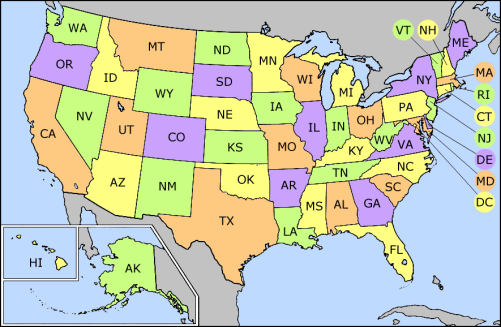
States west of the Mississippi River: AK Alaska AR Arkansas AZ Arizona CA California CO Colorado HI Hawaii IA Iowa ID Idaho KS Kansas LA Louisiana MN Minnesota MO Missouri MT Montana ND North Dakota NE Nebraska NM New Mexico NV Nevada OK Oklahoma OR Oregon SD South Dakota TX Texas UT Utah WA Washington WY Wyoming
These are often divided up into:
- The Western states: AK AZ CA CO HI ID MT NM NV OR UT WA WY
- The South Central states: AR LA OK TX
- The Midwestern states west of the Mississippi (including MN, which is mostly west or north of the river), also called the western Midwest: IA KS MN MO ND NE SD
States east of the Mississippi: AL Alabama CT Connecticut DE Delaware FL Florida GA Georgia IL Illinois IN Indiana KY Kentucky MA Massachusetts MD Maryland ME Maine MI Michigan MS Mississippi NC North Carolina NH New Hampshire NJ New Jersey NY New York OH Ohio PA Pennsylvania RI Rhode Island TN Tennessee VA Virginia VT Vermont WI Wisconsin WV West Virginia
These are often divided up into:
- New England: CT MA ME NH RI VT
- The Mid-Atlantic: DE MD NJ NY PA VA WV
- The Southeast: AL FL GA KY MS NC SC TN
- The Midwestern states east of the Mississippi, also called the eastern Midwest: IL IN MI OH WI
Hardwoods
| Species and a common name | Notes and commercial uses | Eastern distribution
western distribution |
Avg height; growth rate, annual precipitation, minimum temperature |
Tolerance: (D)rought (F)ire, (L)iming and (S)hade |
Landscapes, bark and foliage |
|---|---|---|---|---|---|
| Acacia koa (koa) | An evergreen with highly valued wood: unusually colorful, with a curvy grain and good woodworking properties. The tree grows naturally only in Hawaii, where it is an important part of mountainous rainforests.
Uses: timber; landscaping, sap resins, veneers. |
—
HI |
110 ft (34 m); moderate 50–200 in (130–510 cm) 31 °F (−1 °C) |
D: medium F: medium L: medium S: intolerant |
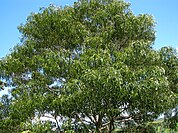  
|
| Acer floridanum (southern sugar maple) | When competing for sunlight, the tree is most often confined to the understory. It is limited mostly to the coastal plains and the Piedmont. POWO lists this as a subspecies of Acer saccharum.
Uses: timber; landscaping, palatable food, pulpwood, veneers. |
IL VA and the Southeast
MO and the South Central states |
50 ft (15 m); moderate 40–65 in (100–170 cm) −18 °F (−28 °C) |
D: medium F: low L: none S: tolerant |
  
|
| Acer macrophyllum (bigleaf maple) | A Pacific Coast tree with valuable wood, used to make furniture and musical instruments, especially piano frames.
Uses: timber; landscaping, palatable food, veneers. |
—
CA OR WA |
60 ft (18 m); rapid 22–260 in (56–660 cm) −14 °F (−26 °C) |
D: low F: low L: high S: medium |
  
|
| Acer negundo (boxelder) | A maple species tolerant to drought and cold. It is broadly distributed in the US, but grows best in alluvial plains.
Uses: landscaping, palatable food, pulpwood. |
All
All but AK HI |
60 ft (18 m); rapid 15–75 in (38–191 cm) −46 °F (−43 °C) |
D: high F: high L: low S: tolerant |
  
|
| Acer nigrum (black maple) | POWO lists this as a subspecies of Acer saccharum, and the wood has similar characteristics. The tree prefers alluvial soils.
Uses: timber; landscaping, palatable food, sap resins, veneers. |
All but FL ME MS RI SC
AR IA KS MN MO SD |
100 ft (30 m); moderate 24–60 in (61–152 cm) −47 °F (−44 °C) |
D: medium F: medium L: low S: tolerant |
 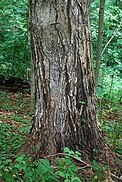 
|
| Acer pensylvanicum (striped maple) | Easily identified by its dusky greenish bark with pale vertical streaks, the tree is often found in shady, cool valleys.
Uses: landscaping. |
GA KY MI NC OH SC TN WI, New England and the Mid-Atlantic
MN |
35 ft (11 m); slow 24–76 in (61–193 cm) −47 °F (−44 °C) |
D: low F: low L: medium S: tolerant |
  
|
| Acer rubrum (red maple) | A fast-growing maple with wood of varying quality. It grows in a variety of environments up to about 3,000 ft (910 m).
Uses: timber; landscaping, palatable food, pulpwood, veneers. |
All
IA MN MO OR and the South Central states |
68 ft (21 m); rapid 25–80 in (64–203 cm) −47 °F (−44 °C) |
D: high F: medium L: low S: medium |
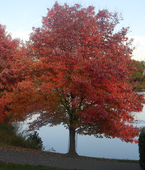  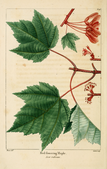
|
| Acer saccharinum (silver maple) | Widely planted as an ornamental. The wood is softer and more brittle than in other maples. In the wild, the tree grows best in damp well-drained alluvial soil.
Uses: timber; landscaping, palatable food, veneers. |
All
CA NM OR, the western Midwest and the South Central states |
90 ft (27 m); rapid 20–70 in (51–178 cm) −47 °F (−44 °C) |
D: medium F: low L: low S: medium |
 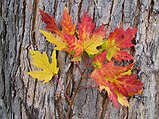 
|
| Acer saccharum (sugar maple) | The primary source of maple syrup. One of the largest and most common North American maples.
Uses: timber; palatable food, pulpwood, sap resins, veneers. |
All but FL SC
the western Midwest and the South Central states |
100 ft (30 m); slow 22–80 in (56–203 cm) −47 °F (−44 °C) |
D: medium F: medium L: low S: tolerant |
  
|
| Aesculus flava (yellow buckeye) | The largest species of the genus, with light wood, used for pulp and wooden utensils. Seen most often in the Great Smoky Mountains in the southern Appalachians. The seeds contain a toxic glucoside.
Uses: landscaping, pulpwood. |
IL IN OH, the Mid-Atlantic and the Southeast
— |
65 ft (20 m); moderate 39–84 in (99–213 cm) −18 °F (−28 °C) |
D: medium F: low L: low S: tolerant |
 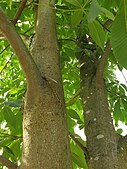 
|
| Aesculus glabra (Ohio buckeye) | The timber is often unmarketable, and the seeds contain a toxic glucoside. The tree prefers damp soil near waterways.
Uses: timber; landscaping, pulpwood. |
AL GA KY ME MS NH TN, the eastern Midwest and the Mid-Atlantic
the western Midwest and the South Central states |
68 ft (21 m); rapid 30–60 in (76–152 cm) −33 °F (−36 °C) |
D: medium F: medium L: low S: tolerant |
  
|
| Alnus rubra (red alder) | A common pioneer hardwood of the coastal northwestern US. Hosts nitrogen-fixing bacteria.
Uses: timber; landscaping, pulpwood, veneers. |
—
AK CA ID MT OR WA |
90 ft (27 m); rapid 24–220 in (61–559 cm) −22 °F (−30 °C) |
D: low F: medium L: high S: intolerant |
  
|
| Arbutus menziesii (Pacific madrone) | A generally non-commercial hardwood with a wide native distribution along the Pacific coast.
Uses: timber; landscaping, veneers. |
—
CA OR WA |
80 ft (24 m); slow 15–163 in (38–414 cm) 13 °F (−11 °C) |
D: low F: high L: medium S: medium |
  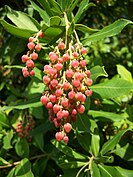
|
| Betula alleghaniensis (yellow birch) | The most economically productive birch native to the US, used for plywood, furniture and carpentry. Often found in damp soils with good drainage in hilly terrain.
Uses: timber; palatable food, veneers. |
GA KY NC SC TN, the eastern Midwest, New England and the Mid-Atlantic
IA MN |
75 ft (23 m); slow 25–80 in (64–203 cm) −47 °F (−44 °C) |
D: low F: medium L: low S: medium |
 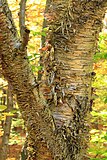 
|
| Betula lenta (sweet birch) | The wintergreen-scented wood, which turns dark when exposed to air, was traditionally used as a substitute for mahogany. It grows at a maximum altitude of 4,500 ft (1,400 m) in its southern range.
Uses: timber; pulpwood, veneers. |
OH, the Mid-Atlantic, New England and the Southeast
— |
60 ft (18 m); moderate 29–80 in (74–203 cm) −26 °F (−32 °C) |
D: low F: medium L: low S: intolerant |
  
|
| Betula nigra (river birch) | Not commercially important, but its strong wood is used locally to make toys and furniture. Often planted as an ornamental.
Uses: pulpwood, veneers. |
All but ME RI
IA KS MN MO and the South Central states |
70 ft (21 m); rapid 30–80 in (76–203 cm) −31 °F (−35 °C) |
D: none F: low L: medium S: intolerant |
  
|
| Betula papyrifera (paper birch) | The birch with the broadest distribution in North America. Commercially important for veneer and pulpwood. It grows best on sites with damp sandy loam.
Uses: landscaping, palatable food, pulpwood, veneers. |
NC TN, the eastern Midwest, New England and the Mid-Atlantic
CO IA MN ND NE SC and the six northernmost Western states |
70 ft (21 m); rapid 12–60 in (30–152 cm) −62 °F (−52 °C) |
D: low F: low L: high S: intolerant |
  
|
| Carpinus caroliniana (American hornbeam) | Traditionally used to make utensils, but of little economic importance today. It grows in a variety of soils and habitats.
Uses: landscaping, sap resins. |
All
IA MN MO and the South Central states |
30 ft (9.1 m); slow 23–80 in (58–203 cm) −34 °F (−37 °C) |
D: low F: low L: low S: tolerant |
  
|
| Carya aquatica (water hickory) | A dominant species in some ecologically important floodlands and wetland forests. It prefers warm, humid habitats.
Uses: fuelwood (locally). |
IL IN VA and the Southeast
MO and the South Central states |
85 ft (26 m); slow 35–70 in (89–178 cm) −18 °F (−28 °C) |
D: low F: medium L: medium S: medium |
  
|
| Carya cordiformis (bitternut hickory) | A relative of the pecan, with a broader range that extends farther north. Its dark-brown, shock-resistant wood is used to make furniture, tools and ladders. It is commonly seen in swamps and damp valleys.
Uses: timber; palatable food, pulpwood, sap resins, veneers. |
All
the South Central states and the western Midwest |
75 ft (23 m); slow 25–70 in (64–178 cm) −47 °F (−44 °C) |
D: high F: high L: medium S: intolerant |
  
|
| Carya glabra (pignut hickory) | A common hickory species, often seen on hilltops and slopes. The large, nutritious nuts, along with the twigs, bark and leaves, provide food for rodents, birds, deer and other mammals.
Uses: timber; palatable food, sap resins, veneers. |
All but ME WI
MO NE and the South Central states |
80 ft (24 m); slow 30–80 in (76–203 cm) −30 °F (−34 °C) |
D: high F: high L: medium S: medium |
  
|
| Carya illinoinensis (pecan) | The nuts are widely used in desserts and baking, and the wood is occasionally used in furniture and carpentry. Often grows on permeable, loamy soils.
Uses: timber; landscaping, palatable food, veneers. |
IL IN MD OH VA and the Southeast
IA KS MO and the South Central states |
120 ft (37 m); slow 28–79 in (71–201 cm) −21 °F (−29 °C) |
D: low F: low L: low S: intolerant |
  
|
| Carya laciniosa (shellbark hickory) | Broadly, but not commonly, distributed. The wood is used for tool handles and furniture. The nuts are the largest among the hickories, providing food for wildlife.
Uses: timber; palatable food, sap resins, veneers. |
ME, the eastern Midwest, the Mid-Atlantic and the Southeast
IA KS MO and the South Central states |
100 ft (30 m); slow 30–60 in (76–152 cm) −22 °F (−30 °C) |
D: high F: low L: medium S: tolerant |
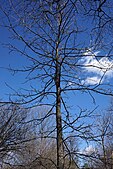  
|
| Carya myristiciformis (nutmeg hickory) | Only small populations remain of this hickory, generally found on damp, nutrient-rich soils. The nuts are high in oils and nutritious for wildlife.
Uses: timber; palatable food, pulpwood, sap resins. |
The Southeast
the South Central states |
95 ft (29 m); slow 40–60 in (100–150 cm) −10 °F (−23 °C) |
D: low F: low L: low S: intolerant |
  
|
| Carya ovata (shagbark hickory) | Mature specimens can be identified by the peeling bark. It grows well in humid climates. This species and Carya glabra account for much of the supply of hickory wood in the US.
Uses: timber; palatable food, pulpwood, sap resins. |
All but FL
the South Central states and the western Midwest |
75 ft (23 m); slow 29–80 in (74–203 cm) −40 °F (−40 °C) |
D: medium F: medium L: medium S: medium |
  
|
| Carya tomentosa (mockernut hickory) | The most abundant of the American hickories. The wood is hard and flexible. Often found in humid uplands.
Uses: timber; palatable food, pulpwood, sap resins, veneers. |
All but ME VT WI
IA KS MO and the South Central states |
85 ft (26 m); slow 32–80 in (81–203 cm) −33 °F (−36 °C) |
D: high F: medium L: medium S: medium |
  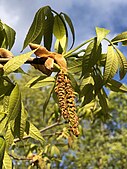
|
| Celtis laevigata (sugarberry) | Adapted to damp sandy or rocky soils. The moderately strong light-yellow wood is used in furniture.
Uses: timber; landscaping, sap resins, veneers. |
IL IN MD OH VA WV and the Southeast
KS MO, the South Central states and the continental Western states |
80 ft (24 m); moderate 20–80 in (51–203 cm) −21 °F (−29 °C) |
D: medium F: low L: medium S: tolerant |
  
|
| Celtis occidentalis (common hackberry) | The wood is similar in quality to most elm wood. The berries persist in cold months, providing sustenance for birds and other animals. The tree thrives in a range of soils and habitats.
Uses: landscaping. |
All but ME
CO MT NM UT WY, the western Midwest and the South Central states |
60 ft (18 m); rapid 14–60 in (36–152 cm) −47 °F (−44 °C) |
D: medium F: high L: low S: tolerant |
  
|
| Cercis canadensis (eastern redbud) | A popular early-blooming ornamental, and a food source for birds, wildlife and livestock. It grows best on damp, drained soils, but not on coarse sand.
Uses: landscaping, palatable food. |
CT MA, the eastern Midwest, the Mid-Atlantic and the Southeast
IA KS MO NE NM and the South Central states |
30 ft (9.1 m); slow 20–80 in (51–203 cm) −28 °F (−33 °C) |
D: low F: high L: medium S: tolerant |
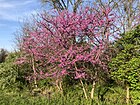  
|
| Chrysolepis chrysophylla (giant chinquapin) | Appears mainly in forests dominated by conifers. Its marketability is hampered by difficulties in drying the wood. It grows in a range of habitats, but is rarely the dominant tree in any of them.
Uses: landscaping, palatable food. |
—
CA OR WA |
100 ft (30 m); moderate 34–130 in (86–330 cm) −34 °F (−37 °C) |
D: low F: high L: high S: tolerant |
  
|
| Cornus florida (flowering dogwood) | A popular ornamental. The white or pinkish "flowers" are actually bracts. Its shallow roots do poorly on dry sites.
Uses: landscaping. |
All but WI
KS MO and the South Central states |
30 ft (9.1 m); moderate 28–80 in (71–203 cm) −28 °F (−33 °C) |
D: low F: low L: medium S: tolerant |
  
|
| Diospyros virginiana (common persimmon) | The fruit can be fermented or used in baking. The wood is heavy, hard and smooth-grained. The tree thrives in a variety of conditions.
Uses: landscaping, palatable food. |
All but ME MI NH RI VT WI
CA IA KS MO NE UT and the South Central states |
55 ft (17 m); slow 30–80 in (76–203 cm) −21 °F (−29 °C) |
D: none F: medium L: medium S: tolerant |
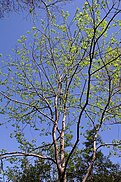  
|
| Fagus grandifolia (American beech) | The wood is easily cut, shaped and treated, and is used for furniture and carpentry. The tree is common in the Mississippi and Ohio river valleys.
Uses: timber; landscaping, palatable food, pulpwood, sap resins, veneers. |
All
MN MO UT and the South Central states |
80 ft (24 m); slow 28–80 in (71–203 cm) −44 °F (−42 °C) |
D: low F: high L: medium S: tolerant |
  
|
| Fraxinus americana (white ash) | The most valuable timber tree of the ashes. Its many uses include baseball bats, tools, furniture and carpentry. It thrives on rich, damp soils.
Uses: timber; landscaping, sap resins. |
All
CO IA KS MN MO NE and the South Central states |
90 ft (27 m); moderate 28–80 in (71–203 cm) −34 °F (−37 °C) |
D: medium F: low L: medium S: intolerant |
  
|
| Fraxinus latifolia (Oregon ash) | The only native ash tree of the Pacific Northwest. The wood is easy to split and a good fuel source.
Uses: landscaping, sap resins. |
—
CA OR WA |
70 ft (21 m); moderate 20–118 in (51–300 cm) −8 °F (−22 °C) |
D: low F: low L: medium S: medium |
  
|
| Fraxinus nigra (black ash) | The wood separates easily and has often been bent and woven into baskets, hoops and furniture. Usually seen in waterlogged northern forestland.
Uses: timber; sap resins, veneers. |
KY, the eastern Midwest, the Mid-Atlantic and New England
IA MN ND |
65 ft (20 m); slow 20–50 in (51–127 cm) −47 °F (−44 °C) |
D: unknown F: low L: medium S: intolerant |
  
|
| Fraxinus pennsylvanica (green ash) | The ash with the widest distribution in the US. The wood is similar to that of white ash.
Uses: timber; landscaping, sap resins. |
All
CO MT NM UT WY, the South Central states and the western Midwest |
80 ft (24 m); rapid 15–71 in (38–180 cm) −47 °F (−44 °C) |
D: high F: medium L: medium S: tolerant |
  
|
| Fraxinus profunda (pumpkin ash) | The common name comes from the swelling it often develops at the base of the trunk when growing in swampland or damp bottomland. The wood is used for construction timber and tool implements.
Uses: timber; landscaping, sap resins. |
All but WI WV and New England
AR LA MO |
120 ft (37 m); rapid 36–70 in (91–178 cm) −24 °F (−31 °C) |
D: none F: low L: high S: medium |
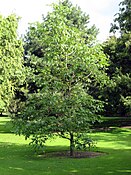  
|
| Gleditsia triacanthos (honeylocust) | Some thornless varieties are popular urban ornamentals, especially near pavement or where only partial shade is desired. Often seen in damp bottomlands or limestone soils.
Uses: timber; landscaping, pulpwood. |
All
all but AK HI OR WA |
70 ft (21 m); rapid 20–70 in (51–178 cm) −36 °F (−38 °C) |
D: medium F: high L: medium S: intolerant |
  
|
| Gordonia lasianthus (loblolly bay) | Found in acidic and swampy soils near the Gulf and southern Atlantic coasts. Popular as an ornamental for its profuse flowers.
Uses: landscaping, pulpwood. |
The Southeast
— |
65 ft (20 m); slow 44–70 in (110–180 cm) −4 °F (−20 °C) |
D: none F: low L: low S: tolerant |
  
|
| Halesia carolina (Carolina silverbell) | Flourishes in the southern Appalachians. The light, fine-grained wood is used in veneers, carpentry, and kitchen utensils and implements.
Uses: timber; pulpwood, veneers. |
AL FL GA MS NY SC
— |
30 ft (9.1 m); moderate 40–80 in (100–200 cm) −10 °F (−23 °C) |
D: low F: low L: low S: tolerant |
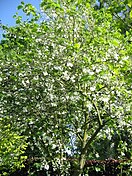 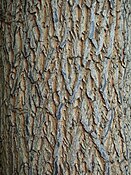 
|
| Ilex opaca (American holly) | Planted as an ornamental and for winter holiday decorations. The red berries attract white-tailed deer and many bird species. The range overlaps that of loblolly and shortleaf pine.
Uses: landscaping, pulpwood, veneers. |
All but ME MI NH VT WI
MO and the South Central states |
40 ft (12 m); slow 40–80 in (100–200 cm) −20 °F (−29 °C) |
D: low F: medium L: low S: tolerant |
  
|
| Juglans cinerea (butternut) | Maple-butternut candy is traditional in New England. The wood has been used for carpentry and furniture, but populations of the tree are declining.
Uses: timber; landscaping, palatable food, pulpwood, veneers. |
All but FL
AR IA MN MO |
80 ft (24 m); rapid 25–80 in (64–203 cm) −33 °F (−36 °C) |
D: none F: low L: low S: intolerant |
 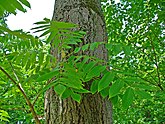 
|
| Juglans nigra (black walnut) | Natural groves are scarce from overlogging, but those remaining are valuable sources of veneers.
Uses: timber; landscaping, palatable food, veneers. |
All but VT
CO NM UT, the South Central states and the western Midwest |
100 ft (30 m); rapid 30–60 in (76–152 cm) −28 °F (−33 °C) |
D: high F: low L: high S: intolerant |
  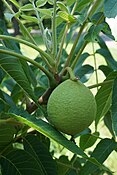
|
| Liquidambar styraciflua (sweetgum) | A common tree in Southeastern bottomland. The scented sap is used in medicines and perfumes, and the wood is used for carpentry and utensils.
Uses: timber; landscaping, pulpwood, sap resins, veneers. |
All but ME MI NH VT WI
CA MO and the South Central states |
100 ft (30 m); rapid 40–60 in (100–150 cm) −21 °F (−29 °C) |
D: low F: low L: low S: intolerant |
  
|
| Liriodendron tulipifera (tuliptree) | A common ornamental, and also in demand as a fast-growing source of light wood for construction and furniture. The tree is most common on the lower slopes of the Appalachians and in the Piedmont.
Uses: timber; landscaping, pulpwood, sap resins, veneers. |
All but ME NH WI
IA MO and the South Central states |
120 ft (37 m); rapid 30–80 in (76–203 cm) −18 °F (−28 °C) |
D: low F: low L: medium S: intolerant |
  
|
| Maclura pomifera (osage orange) | One of the most-planted tree species in North America. It now provides decay-resistant fence posts, but from the mid-1800s until the adoption of barbed wire, it was widely used for prairie hedges.
Uses: landscaping. |
All but ME NH VT
CA CO NM OR UT WA, the South Central states and the western Midwest |
35 ft (11 m); moderate 24–40 in (61–102 cm) −23 °F (−31 °C) |
D: high F: medium L: medium S: intolerant |
  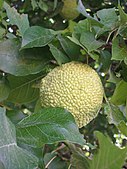
|
| Magnolia acuminata (cucumber tree) | A common ornamental, with the widest distribution in the US among native magnolias. The wood is similar to tuliptree.
Uses: timber; landscaping. |
All but DE ME MI NH RI VT WI
MO and the South Central states |
100 ft (30 m); rapid 35–60 in (89–152 cm) −16 °F (−27 °C) |
D: low F: none L: none S: medium |
 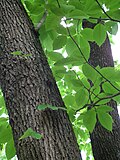 
|
| Magnolia fraseri (mountain magnolia) | A small ornamental tree of the southern Appalachians, with large white flowers.
Uses: timber; landscaping, pulpwood. |
NY OH VA WV and the Southeast
— |
75 ft (23 m); rapid 40–80 in (100–200 cm) −13 °F (−25 °C) |
D: low F: low L: medium S: medium |
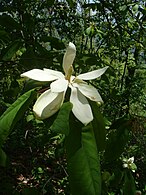  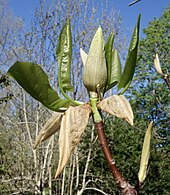
|
| Magnolia grandiflora (southern magnolia) | An ornamental tree in the Southeast, and increasingly common worldwide, with large perfumed white flowers and leathery evergreen leaves. It is resistant to damage by high winds and air pollutants such as sulfur dioxide.
Uses: timber; landscaping. |
MD PA VA and the Southeast
the South Central states |
100 ft (30 m); moderate 35–60 in (89–152 cm) 7 °F (−14 °C) |
D: low F: low L: low S: tolerant |
 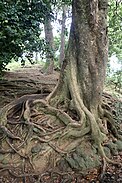 
|
| Magnolia virginiana (sweetbay) | Often seen on wet or acid soils of the coastal plains. More tolerant of wet and dry soils than other magnolias. Sometimes confused with other bay trees, such as Gordonia lasianthus and Persea borbonia.
Uses: landscaping, pulpwood, veneers. |
MA, the Mid-Atlantic and the Southeast
the South Central states |
60 ft (18 m); moderate 40–80 in (100–200 cm) 17 °F (−8 °C) |
D: none F: none L: none S: medium |
  
|
| Metrosideros polymorpha (ohia lehua) | The most widely distributed tree in Hawaii, and generally the first to appear on new lava deposits. Often starts its life cycle as an epiphyte.
Uses: timber; sap resins. |
—
HI |
65 ft (20 m); slow 20–450 in (51–1,143 cm) 22 °F (−6 °C) |
D: none F: low L: high S: intolerant |
  
|
| Morus rubra (red mulberry) | Widespread across the eastern US. The wood is used locally for furniture, carpentry and posts, but the tree is best known for its fruit, used in desserts, preserves and drinks.
Uses: timber; landscaping, palatable food, veneers. |
All but ME NH
the South Central states and the western Midwest |
70 ft (21 m); moderate 35–60 in (89–152 cm) −33 °F (−36 °C) |
D: medium F: medium L: low S: tolerant |
 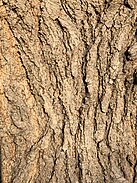 
|
| Nyssa aquatica (water tupelo) | A tupelo of flood plains and swamps mainly of the Southeast and South Central states. Used commercially to make furniture and boxes.
Uses: timber; pulpwood. |
IL VA and the Southeast
MO and the South Central states |
100 ft (30 m); moderate 40–60 in (100–150 cm) −23 °F (−31 °C) |
D: none F: none L: low S: intolerant |
  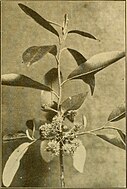
|
| Nyssa ogeche (Ogeechee tupelo) | An uncommon tree that prefers wet soils of the coastal plains. Valued mostly for its fruits and honey.
Uses: palatable food. |
AL FL GA SC
— |
50 ft (15 m); rapid 45–60 in (110–150 cm) −8 °F (−22 °C) |
D: low F: low L: medium S: intolerant |
  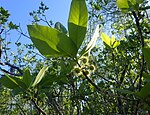
|
| Nyssa sylvatica (blackgum) | An important food source for wildlife. It prefers lightweight soils of both upland and bottomland, and is used for boxes, posts and piers.
Uses: landscaping. |
All
KS MO and the South Central states |
95 ft (29 m); moderate 40–60 in (100–150 cm) −18 °F (−28 °C) |
D: none F: low L: low S: tolerant |
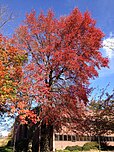 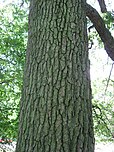 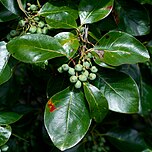
|
| Ostrya virginiana (hophornbeam) | A short understory tree that tolerates a wide variety of soils. Not an evergreen, but it retains its leaves for much of the winter. Used for landscaping and to make tools.
Uses: landscaping, sap resins. |
All
WY, the western Midwest and the South Central states |
45 ft (14 m); slow 18–60 in (46–152 cm) −38 °F (−39 °C) |
D: medium F: medium L: medium S: tolerant |
 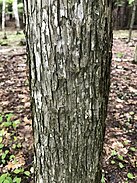 
|
| Oxydendrum arboreum (sourwood) | A mid-canopy and understory tree of the Appalachians and Piedmont. Also known as lily-of-the-valley tree for its flowers, which are a source of honey in some areas.
Uses: landscaping. |
IL IN OH RI, the Southeast and the Mid-Atlantic
AR LA |
35 ft (11 m); slow 30–40 in (76–102 cm) −13 °F (−25 °C) |
D: none F: medium L: low S: tolerant |
  
|
| Persea borbonia (redbay) | Often seen in swamp forests of the coastal plains. An evergreen tree with leaves that are sometimes used as a seasoning. POWO classifies this species as Tamala borbonia.
Uses: landscaping, palatable food. |
The Southeast
the South Central states |
70 ft (21 m); moderate 40–80 in (100–200 cm) 7 °F (−14 °C) |
D: none F: low L: none S: tolerant |
 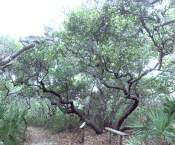 
|
| Platanus occidentalis (American sycamore) | Used mainly for pulp and for rough, sturdy timber, including in butcher blocks. It is used for soil regeneration, but thrives best in rich alluvial soils. Sometimes confused with other Platanus trees or with the sycamore maple (Acer pseudoplatanus).
Uses: timber; landscaping. |
All
IA KS MO NE WA and the South Central states |
100 ft (30 m); rapid 30–80 in (76–203 cm) −34 °F (−37 °C) |
D: none F: low L: medium S: medium |
  
|
| Populus balsamifera (balsam poplar) | Thrives on flood plains, but also grows on upland. The light wood is used for pulp and lightweight construction.
Uses: timber; pulpwood. |
The eastern Midwest, the Mid-Atlantic and New England
IA MN ND SD and the continental Western states |
80 ft (24 m); rapid 6–70 in (15–178 cm) −79 °F (−62 °C) |
D: high F: low L: high S: intolerant |
 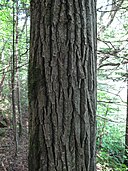 
|
| Populus deltoides (eastern cottonwood) | Sometimes classified as a species, sometimes as the subspecies deltoides. A large tree with light wood that prefers damp silt or fine sand. It has the fastest growth rate among forest-inventory trees in North America.
Uses: timber; pulpwood, veneers. |
All
AZ CO MT NM UT WY, the western Midwest and the South Central states |
190 ft (58 m); rapid 18–55 in (46–140 cm) −43 °F (−42 °C) |
D: medium F: medium L: medium S: intolerant |
  
|
| Populus grandidentata (bigtooth aspen) | Thrives in alluvial soils and, in higher elevations, in sandy soils. The light wood is suited for pulp. The leaves, flower buds and small shoots feed grouse, moose and other wildlife.
Uses: timber; pulpwood, veneers. |
KY NC TN, the eastern Midwest, the Mid-Atlantic and New England
IA MN MO ND |
65 ft (20 m); rapid 20–70 in (51–178 cm) −43 °F (−42 °C) |
D: medium F: low L: high S: intolerant |
  
|
| Populus heterophylla (swamp cottonwood) | Can tolerate submerged soils, unlike other native poplars. It is not often felled for its wood, but when it is, the wood is similar to, and often sold with, eastern cottonwood.
Uses: pulpwood, veneers. |
All but ME NH VT WI WV
AR LA MO |
100 ft (30 m); moderate 35–60 in (89–152 cm) −23 °F (−31 °C) |
D: low F: low L: medium S: intolerant |
 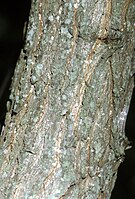 
|
| Populus tremuloides (quaking aspen) | Native to every region of the US. An important source of pulp and engineered wood products. Often used in landscaping, but the aggressive roots can damage nearby structures.
Uses: timber; landscaping, pulpwood, veneers. |
NC KY, the eastern Midwest, the Mid-Atlantic and New England
AR TX, the continental Western states and the western Midwest |
65 ft (20 m); rapid 7–60 in (18–152 cm) −70 °F (−57 °C) |
D: high F: low L: high S: intolerant |
  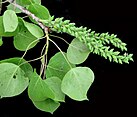
|
| Prunus pensylvanica (pin cherry) | An important pioneer species, sometimes called fire cherry for its use in reforestation after wildfires. It grows in a wide variety of soils.
Uses: palatable food, pulpwood. |
All but AL DE FL MS SC
CO IA MN MT ND SD WY |
30 ft (9.1 m); rapid 16–80 in (41–203 cm) −38 °F (−39 °C) |
D: none F: low L: high S: intolerant |
  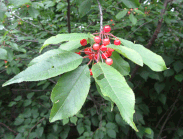
|
| Prunus serotina (black cherry) | The only native cherry tree harvested commercially for wood, mainly on the Allegheny Plateau. Wilted leaves contain the toxin cyanide.
Uses: timber; landscaping, palatable food, sap resins, veneers. |
All
AZ NM WA and the western Midwest |
80 ft (24 m); rapid 21–50 in (53–127 cm) −33 °F (−36 °C) |
D: high F: medium L: low S: intolerant |
  
|
| Quercus alba (white oak) | Yields high-quality wood that tolerates a range of soils. The acorns are an important food source for more than 180 wildlife species.
Uses: timber; landscaping, sap resins, veneers. |
All
the South Central states and the western Midwest |
100 ft (30 m); slow 30–80 in (76–203 cm) −43 °F (−42 °C) |
D: medium F: medium L: medium S: medium |
  
|
| Quercus bicolor (swamp white oak) | Generally found in bottomlands and waterlogged areas. The wood is similar to but knottier than white oak wood.
Uses: timber; landscaping, sap resins, veneers. |
All but FL GA
IA MN MO |
100 ft (30 m); rapid 36–48 in (91–122 cm) −28 °F (−33 °C) |
D: low F: low L: medium S: medium |
  
|
| Quercus chrysolepis (canyon live oak) | A tall tree in ideal conditions, but tends to be shrubby on exposed or dry slopes. Pioneering settlers in California used the wood for tools, furniture and fuel.
Uses: landscaping, veneers. |
—
AZ CA NM NV OR |
90 ft (27 m); slow 6–110 in (15–279 cm) 11 °F (−12 °C) |
D: none F: high L: medium S: tolerant |
  
|
| Quercus coccinea (scarlet oak) | A timber tree with striking autumn colors that tolerates a range of soils and conditions.
Uses: timber; landscaping, sap resins, veneers. |
All but FL
AR LA MO |
70 ft (21 m); rapid 30–55 in (76–140 cm) −28 °F (−33 °C) |
D: low F: medium L: medium S: intolerant |
  
|
| Quercus douglasii (blue oak) | Accounts for a significant amount of the oak forestland in California. The wood is strong but not often harvested because of the short, irregular trunks.
Uses: palatable food. |
—
CA |
60 ft (18 m); slow 10–60 in (25–152 cm) 10 °F (−12 °C) |
D: none F: high L: low S: intolerant |
  
|
| Quercus falcata (southern red oak) | Frequently seen on uplands in the southern states. The wood is coarse-grained and hard.
Uses: timber; veneers. |
All but MI WI and New England
MO and the South Central states |
75 ft (23 m); moderate 40–80 in (100–200 cm) −13 °F (−25 °C) |
D: medium F: high L: low S: medium |
  
|
| Quercus garryana (Oregon white oak) | Usually seen inland from the Pacific coast. Used locally for furniture and carpentry.
Uses: timber; palatable food, sap resins. |
—
CA OR WA |
80 ft (24 m); slow 10–104 in (25–264 cm) −33 °F (−36 °C) |
D: none F: high L: low S: intolerant |
  
|
| Quercus kelloggii (California black oak) | Similar to northern red oak, the wood is suitable for paneling, furniture, carpentry and pallets. It has the widest distribution in California among the western oaks.
Uses: timber; landscaping, palatable food, sap resins. |
—
CA OR |
85 ft (26 m); slow 12–100 in (30–254 cm) −3 °F (−19 °C) |
D: low F: medium L: low S: intolerant |
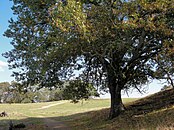  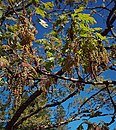
|
| Quercus laevis (turkey oak) | Prefers sandy, dry soils. Generally too small for commercial harvesting, but the wood makes good fuel.
Uses: fuelwood (locally). |
VA and the Southeast
LA |
40 ft (12 m); rapid 40–70 in (100–180 cm) −3 °F (−19 °C) |
D: none F: high L: medium S: intolerant |
  
|
| Quercus laurifolia (laurel oak) | Grows in damp forests of the coastal plains. Used as an ornamental and for fuel.
Uses: landscaping, pulpwood. |
MD PA VA and the Southeast
the South Central states |
70 ft (21 m); rapid 40–70 in (100–180 cm) −3 °F (−19 °C) |
D: none F: low L: low S: tolerant |
  
|
| Quercus lyrata (overcup oak) | Grows well on submerged soils of the Southeast. The timber is of variable quality.
Uses: landscaping. |
DE MD IL IN NJ VA and the Southeast
MO and the South Central states |
80 ft (24 m); moderate 36–60 in (91–152 cm) −23 °F (−31 °C) |
D: low F: none L: low S: medium |
  
|
| Quercus macrocarpa (bur oak) | An extensive root system helps the tree survive droughts. Most of the timber harvest is from lowlands in Iowa and Illinois.
Uses: timber; landscaping. |
All but FL GA NC SC
CO MT NM, the western Midwest and the South Central states |
100 ft (30 m); slow 15–50 in (38–127 cm) −38 °F (−39 °C) |
D: medium F: high L: high S: medium |
  
|
| Quercus michauxii (swamp chestnut oak) | An important timber tree of the southern states, growing mostly on damp and wet bottomlands. The wood has many uses, including in basketry.
Uses: timber; sap resins, veneers. |
DE MD IL IN NJ VA and the Southeast
MO and the South Central states |
80 ft (24 m); moderate 40–70 in (100–180 cm) −20 °F (−29 °C) |
D: none F: low L: low S: intolerant |
  
|
| Quercus muehlenbergii (chinquapin oak) | Prefers limestone uplands and slopes with permeable soils. Not usually abundant enough for commercial harvesting.
Uses: fuelwood (locally). |
All but DE ME NH RI
NM, the South Central states and the western Midwest |
70 ft (21 m); moderate 20–90 in (51–229 cm) −33 °F (−36 °C) |
D: high F: high L: low S: intolerant |
  
|
| Quercus nigra (water oak) | Frequently seen in lowlands, especially near waterways, in the Southeast. Used for timber and fuel.
Uses: timber; landscaping, veneers. |
DE MD IL NJ VA and the Southeast
MO and the South Central states |
90 ft (27 m); rapid 35–70 in (89–178 cm) −20 °F (−29 °C) |
D: none F: low L: high S: intolerant |
  
|
| Quercus palustris (pin oak) | Used for fuel, pulp and railroad ties; other uses are limited because the wood can warp when drying. Found on damp and wet soils, especially clay soils of the Ohio Valley.
Uses: timber; landscaping, veneers. |
All but AL FL NH SC VT
AR IA KS MO NE OK |
100 ft (30 m); rapid 32–60 in (81–152 cm) −33 °F (−36 °C) |
D: low F: low L: medium S: intolerant |
  
|
| Quercus phellos (willow oak) | Widely planted as an ornamental. Harvested for timber and pulp. Grows rapidly on damp alluvial soils, often near waterways.
Uses: timber; landscaping, pulpwood. |
CT IL OH, the Southeast and the Mid-Atlantic
MO and the South Central states |
100 ft (30 m); rapid 40–70 in (100–180 cm) −23 °F (−31 °C) |
D: none F: none L: low S: intolerant |
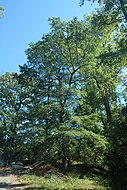  
|
| Quercus rubra (northern red oak) | A common tree in the eastern US, adapted to a variety of soils. An important source of hard, heavy timber. It is urban-tolerant and has been used for soil regeneration.
Uses: timber; landscaping, sap resins, veneers. |
All but FL
the western Midwest and the South Central states |
81 ft (25 m); moderate 30–80 in (76–203 cm) −35 °F (−37 °C) |
D: low F: low L: high S: medium |
  
|
| Quercus shumardii (Shumard) | A large red oak that prefers damp, porous soils. The wood is marketed along with other red oak wood for furniture and carpentry.
Uses: timber; sap resins, veneers. |
All but DE NJ WI and New England
KS MO and the South Central states |
100 ft (30 m); moderate 25–70 in (64–178 cm) −22 °F (−30 °C) |
D: low F: high L: low S: intolerant |
  
|
| Quercus stellata (post oak) | Prevalent throughout the Southeast and South Central states. Sometimes planted to protect soil on stony and dry sites.
Uses: timber; pulpwood, veneers. |
ME MI NH VT WI
IA KS MO and the South Central states |
60 ft (18 m); slow 22–80 in (56–203 cm) −33 °F (−36 °C) |
D: medium F: high L: medium S: intolerant |
  
|
| Quercus texana (Nuttall oak) | The tree is similar to pin oak, and the wood is often marketed with red oak. It grows well on many soils, including clay soils with low permeability.
Uses: timber; sap resins, veneers. |
AL IL KY MS TN
MO and the South Central states |
110 ft (34 m); rapid 40–65 in (100–170 cm) −18 °F (−28 °C) |
D: none F: none L: none S: intolerant |
  
|
| Quercus velutina (black oak) | Grows on a variety of soils in the eastern and midwestern US. The wood is often marketed with red oak.
Uses: timber; veneers. |
All
the South Central states and the western Midwest |
80 ft (24 m); moderate 30–80 in (76–203 cm) −30 °F (−34 °C) |
D: low F: low L: medium S: medium |
  
|
| Quercus virginiana (live oak) | Abundant on partly damp to partly dry soils in much of its range. The wood is strong and heavy, among the densest for North American trees.
Uses: timber; landscaping, pulpwood. |
VA and the Southeast
LA TX UT |
50 ft (15 m); rapid 32–70 in (81–178 cm) 7 °F (−14 °C) |
D: none F: medium L: low S: medium |
  
|
| Robinia pseudoacacia (black locust) | Grows best on damp fertile limestone soils. It has become naturalized in the US. Used mostly to improve soils through nitrogen fixation, as a windbreak and for fuel.
Uses: timber; landscaping, pulpwood. |
All
all but AK HI |
60 ft (18 m); rapid 16–65 in (41–165 cm) −37 °F (−38 °C) |
D: high F: high L: high S: intolerant |
  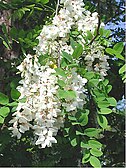
|
| Sabal palmetto (cabbage palmetto) | Tolerates a broad range of damp soils, and even brackish marshes. Planted as an ornamental. The fruit is edible.
Uses: landscaping, palatable food. |
The Southeast
LA TX |
90 ft (27 m); slow 30–70 in (76–178 cm) 16 °F (−9 °C) |
D: medium F: low L: low S: tolerant |
  
|
| Salix nigra (black willow) | The largest and the only regularly harvested native willow in the US. Also planted as an ornamental and to protect soil from eroding. The shallow roots require water access.
Uses: landscaping, pulpwood. |
All
CO, the South Central states and the western Midwest |
100 ft (30 m); rapid 18–80 in (46–203 cm) 58 °F (14 °C) |
D: low F: low L: low S: intolerant |
  
|
| Sassafras albidum (sassafras) | Thrives in the Great Smoky Mountains on damp fertile soils in open areas. The entire tree is strongly scented, and oil from the bark has been used in perfumery.
Uses: landscaping, palatable food. |
All
IA KS MO and the South Central states |
75 ft (23 m); moderate 30–80 in (76–203 cm) −27 °F (−33 °C) |
D: high F: high L: low S: intolerant |
  
|
| Tilia americana (American basswood) | Harvested for timber, especially in and around the Great Lakes. Also a nectar source for honey. Thrives best on layers of fertile, damp soil.
Uses: timber; landscaping, sap resins. |
All
the western Midwest and the South Central states |
100 ft (30 m); moderate 21–80 in (53–203 cm) −46 °F (−43 °C) |
D: low F: low L: medium S: tolerant |
  
|
| Ulmus alata (winged elm) | Named for the winged seeds, called samaras. The tree generally grows where other elms grow, and its wood is marketed along with other elm wood.
Uses: timber. |
IL IN MD VA and the Southeast
KS MO and the South Central states |
65 ft (20 m); moderate 40–70 in (100–180 cm) −18 °F (−28 °C) |
D: low F: low L: unknown S: tolerant |
  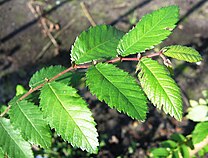
|
| Ulmus americana (American elm) | Has not recovered from the devastation caused by Dutch elm disease over the past century. When available, the wood has many uses, including in furniture and construction.
Uses: timber; pulpwood, sap resins. |
All
CO MT WY, the western Midwest and the South Central states |
120 ft (37 m); rapid 15–70 in (38–178 cm) −46 °F (−43 °C) |
D: medium F: medium L: low S: medium |
  
|
| Ulmus crassifolia (cedar elm) | Prefers damp limestone soils. The very strong wood is marketed with rock elm.
Uses: timber; landscaping. |
FL MS TN
MO and the South Central states |
90 ft (27 m); rapid 20–70 in (51–178 cm) −10 °F (−23 °C) |
D: low F: medium L: low S: medium |
  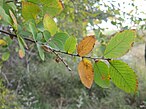
|
| Ulmus rubra (slippery elm) | "Slippery" refers to the inner bark. The tree prefers damp, fertile soils. Susceptible to Dutch elm disease.
Uses: timber; pulpwood. |
All
CO, the western Midwest and the South Central states |
85 ft (26 m); rapid 21–83 in (53–211 cm) −43 °F (−42 °C) |
D: low F: medium L: low S: tolerant |
  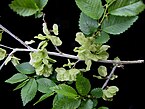
|
| Ulmus serotina (September elm) | Susceptible to Dutch elm disease. Not an abundant species. The wood is marketed with rock elm.
Uses: timber; landscaping. |
AL GA IL KY MS TN
AR OK |
70 ft (21 m); rapid 40–60 in (100–150 cm) −21 °F (−29 °C) |
D: medium F: medium L: low S: tolerant |
  
|
| Ulmus thomasii (rock elm) | Thrives on damp loamy soils. The very hard wood is used in construction and veneers.
Uses: timber; veneers. |
KY TN, the eastern Midwest, the Mid-Atlantic and New England
AR and the western Midwest |
90 ft (27 m); moderate 22–60 in (56–152 cm) −46 °F (−43 °C) |
D: medium F: low L: medium S: medium |
  
|
| Umbellularia californica (California laurel) | Produces an oil similar to camphor that is germicidal, insecticidal and also sometimes toxic for humans. The wood is used in furniture and carpentry.
Uses: timber; landscaping, palatable food, sap resins, veneers. |
—
CA OR |
80 ft (24 m); moderate 13–84 in (33–213 cm) −13 °F (−25 °C) |
D: none F: low L: medium S: tolerant |
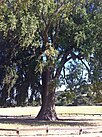  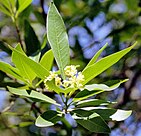
|
See also
Notes
- The taxonomy (classification) on this page comes from Plants of the World Online (POWO) and the US Department of Agriculture's Plants Database except as noted, and omits hybrids and varieties. The 1991 inventory has limited coverage outside Canada and the US, and is not used outside the US in this list.
- When a US region appears in this column, that means that the species has been reported in all, or all but one or two, states in the region.
Citations
- Hupp 2024.
- Burns & Honkala 1990.
- Burns & Honkala 1991.
- ^ POWO.
- ^ National Plant Data Team 2024, Help page.
- ^ Burns & Honkala 1991, pp. i–vi.
- National Plant Data Team 2024, Help Document.
- Burns & Honkala 1990, pp. v–viii.
- ^ National Plant Data Team 2024.
- National Plant Data Team 2024, Acacia koa.
- Whitesell 1990, pp. 17–28.
- National Plant Data Team 2024, Acer floridanum.
- Jones 1990, pp. 29–32.
- National Plant Data Team 2024, Acer macrophyllum.
- Minore & Zasada 1990, pp. 33–40.
- National Plant Data Team 2024, Acer negundo.
- Overton 1990, pp. 41–45.
- National Plant Data Team 2024, Acer nigrum.
- Gabriel 1990, pp. 46–52.
- National Plant Data Team 2024, Acer pensylvanicum.
- Gabriel & Walters 1990, pp. 53–59.
- National Plant Data Team 2024, Acer rubrum.
- Walters & Yawney 1990, pp. 60–69.
- National Plant Data Team 2024, Acer saccharinum.
- Gabriel 1990, pp. 70–77.
- National Plant Data Team 2024, Acer saccharum.
- Godman, Yawney & Tubbs 1990, pp. 78–91.
- National Plant Data Team 2024, Aesculus flava.
- Williams 1990, pp. 96–100.
- National Plant Data Team 2024, Aesculus glabra.
- Williams 1990, pp. 92–95.
- National Plant Data Team 2024, Alnus rubra.
- Harrington 1990, pp. 116–123.
- National Plant Data Team 2024, Arbutus menziesii.
- McDonald & Tappeiner 1990, pp. 124–132.
- National Plant Data Team 2024, Betula alleghaniensis.
- Erdmann 1990, pp. 133–147.
- National Plant Data Team 2024, Betula lenta.
- Lamson 1990, pp. 148–152.
- National Plant Data Team 2024, Betula nigra.
- Grelen 1990, pp. 153–157.
- National Plant Data Team 2024, Betula papyrifera.
- Safford, Bjorkbom & Zasada 1990, pp. 158–171.
- National Plant Data Team 2024, Carpinus caroliniana.
- Metzger 1990, pp. 179–185.
- National Plant Data Team 2024, Carya aquatica.
- Francis 1990, pp. 186–189.
- National Plant Data Team 2024, Carya cordiformis.
- Smith 1990, pp. 190–197.
- National Plant Data Team 2024, Carya glabra.
- Smalley 1990, pp. 198–204.
- National Plant Data Team 2024, Carya illinoinensis.
- Peterson 1990, pp. 205–210.
- National Plant Data Team 2024, Carya laciniosa.
- Schlesinger 1990, pp. 211–214.
- National Plant Data Team 2024, Carya myristiciformis.
- Maisenhelder & Francis 1990, pp. 215–218.
- National Plant Data Team 2024, Carya ovata.
- Graney 1990, pp. 219–225.
- National Plant Data Team 2024, Carya tomentosa.
- Smith 1990, pp. 226–233.
- National Plant Data Team 2024, Celtis laevigata.
- Kennedy 1990, pp. 258–261.
- National Plant Data Team 2024, Celtis occidentalis.
- Krajicek & Williams 1990, pp. 262–265.
- National Plant Data Team 2024, Cercis canadensis.
- Dickson 1990, pp. 266–269.
- National Plant Data Team 2024, Chrysolepis chrysophylla.
- McKee 1990, pp. 234–239.
- National Plant Data Team 2024, Cornus florida.
- McLemore 1990, pp. 278–283.
- National Plant Data Team 2024, Diospyros virginiana.
- Halls 1990, pp. 294–298.
- National Plant Data Team 2024, Fagus grandifolia.
- Tubbs & Houston 1990, pp. 325–332.
- National Plant Data Team 2024, Fraxinus americana.
- Schlesinger 1990, pp. 333–338.
- National Plant Data Team 2024, Fraxinus latifolia.
- Owston 1990, pp. 339–343.
- National Plant Data Team 2024, Fraxinus nigra.
- Wright & Rauscher 1990, pp. 344–347.
- National Plant Data Team 2024, Fraxinus pennsylvanica.
- Kennedy 1990, pp. 348–354.
- National Plant Data Team 2024, Fraxinus profunda.
- Harms 1990, pp. 355–357.
- National Plant Data Team 2024, Gleditsia triacanthos.
- Blair 1990, pp. 358–364.
- National Plant Data Team 2024, Gordonia lasianthus.
- Gresham & Lipscomb 1990, pp. 365–369.
- National Plant Data Team 2024, Halesia carolina.
- Sluder 1990, pp. 374–378.
- National Plant Data Team 2024, Ilex opaca.
- Grelen 1990, pp. 379–385.
- National Plant Data Team 2024, Juglans cinerea.
- Rink 1990, pp. 386–390.
- National Plant Data Team 2024, Juglans nigra.
- Williams 1990, pp. 391–399.
- National Plant Data Team 2024, Liquidambar styraciflua.
- Kormanik 1990, pp. 400–405.
- National Plant Data Team 2024, Liriodendron tulipifera.
- Beck 1990, pp. 406–416.
- National Plant Data Team 2024, Maclura pomifera.
- Burton 1990, pp. 426–432.
- National Plant Data Team 2024, Magnolia acuminata.
- Smith 1990, pp. 433–438.
- National Plant Data Team 2024, Magnolia fraseri.
- Della-Bianca 1990, pp. 439–444.
- National Plant Data Team 2024, Magnolia grandiflora.
- Outcalt 1990, pp. 445–448.
- National Plant Data Team 2024, Magnolia virginiana.
- Priester 1990, pp. 449–454.
- National Plant Data Team 2024, Metrosideros polymorpha.
- Adee & Conrad 1990, pp. 466–469.
- National Plant Data Team 2024, Morus rubra.
- Lamson 1990, pp. 470–473.
- National Plant Data Team 2024, Nyssa aquatica.
- Johnson 1990a, pp. 474–478.
- National Plant Data Team 2024, Nyssa ogeche.
- Kossuth & Scheer 1990, pp. 479–481.
- National Plant Data Team 2024, Nyssa sylvatica.
- McGee 1990, pp. 482–484.
- National Plant Data Team 2024, Ostrya virginiana.
- Metzger 1990, pp. 490–496.
- National Plant Data Team 2024, Oxydendrum arboreum.
- Overton 1990, pp. 497–500.
- National Plant Data Team 2024, Persea borbonia.
- Brendemuehl 1990, pp. 503–506.
- National Plant Data Team 2024, Platanus occidentalis.
- Wells & Schmidtling 1990, pp. 511–517.
- National Plant Data Team 2024, Populus balsamifera.
- Zasada & Phipps 1990, pp. 518–529.
- National Plant Data Team 2024, Populus deltoides.
- Cooper 1990, pp. 530–536.
- National Plant Data Team 2024, Populus grandidentata.
- Laidly 1990, pp. 544–550.
- National Plant Data Team 2024, Populus heterophylla.
- Johnson 1990a, pp. 551–554.
- National Plant Data Team 2024, Populus tremuloides.
- Perala 1990, pp. 555–569.
- National Plant Data Team 2024, Prunus pensylvanica.
- Wendel 1990, pp. 587–593.
- National Plant Data Team 2024, Prunus serotina.
- Marquis 1990, pp. 594–604.
- National Plant Data Team 2024, Quercus alba.
- Rogers 1990, pp. 605–613.
- National Plant Data Team 2024, Quercus bicolor.
- Rogers 1990, pp. 614–617.
- National Plant Data Team 2024, Quercus chrysolepis.
- Thornburgh 1990, pp. 618–624.
- National Plant Data Team 2024, Quercus coccinea.
- Johnson 1990b, pp. 625–630.
- National Plant Data Team 2024, Quercus douglasii.
- McDonald 1990, pp. 631–639.
- National Plant Data Team 2024, Quercus falcata.
- Belanger 1990, pp. 640–643.
- National Plant Data Team 2024, Quercus garryana.
- Stein 1990, pp. 650–660.
- National Plant Data Team 2024, Quercus kelloggii.
- McDonald 1990, pp. 661–671.
- National Plant Data Team 2024, Quercus laevis.
- Harlow 1990, pp. 672–676.
- National Plant Data Team 2024, Quercus laurifolia.
- McReynolds & Hebb 1990, pp. 677–680.
- National Plant Data Team 2024, Quercus lyrata.
- Solomon 1990, pp. 681–685.
- National Plant Data Team 2024, Quercus macrocarpa.
- Johnson 1990b, pp. 686–692.
- National Plant Data Team 2024, Quercus michauxii.
- Edwards 1990, pp. 693–696.
- National Plant Data Team 2024, Quercus muehlenbergii.
- Sander 1990, pp. 697–700.
- National Plant Data Team 2024, Quercus nigra.
- Vozzo 1990, pp. 701–703.
- National Plant Data Team 2024, Quercus palustris.
- McQuilkin 1990, pp. 709–714.
- National Plant Data Team 2024, Quercus phellos.
- Schlaegel 1990, pp. 715–720.
- National Plant Data Team 2024, Quercus rubra.
- Sander 1990, pp. 727–733.
- National Plant Data Team 2024, Quercus shumardii.
- Edwards 1990, pp. 734–737.
- National Plant Data Team 2024, Quercus stellata.
- Stransky 1990, pp. 738–743.
- National Plant Data Team 2024, Quercus texana.
- Filer 1990, pp. 704–708.
- National Plant Data Team 2024, Quercus velutina.
- Sander 1990, pp. 744–750.
- National Plant Data Team 2024, Quercus virginiana.
- Harms 1990, pp. 751–754.
- National Plant Data Team 2024, Robinia pseudoacacia.
- Huntley 1990, pp. 755–761.
- National Plant Data Team 2024, Sabal palmetto.
- Wade & Langdon 1990, pp. 762–767.
- National Plant Data Team 2024, Salix nigra.
- Pitcher & McKnight 1990, pp. 768–772.
- National Plant Data Team 2024, Sassafras albidum.
- Griggs 1990, pp. 773–777.
- National Plant Data Team 2024, Tilia americana.
- Crow 1990, pp. 784–791.
- National Plant Data Team 2024, Ulmus alata.
- Snow 1990, pp. 797–800.
- National Plant Data Team 2024, Ulmus americana.
- Bey 1990, pp. 801–807.
- National Plant Data Team 2024, Ulmus crassifolia.
- Stransky & Bierschenk 1990, pp. 808–811.
- National Plant Data Team 2024, Ulmus rubra.
- Cooley & Sambeek 1990, pp. 812–816.
- National Plant Data Team 2024, Ulmus serotina.
- Lawson 1990, pp. 817–820.
- National Plant Data Team 2024, Ulmus thomasii.
- Crow 1990, pp. 821–825.
- National Plant Data Team 2024, Umbellularia californica.
- Stein 1990, pp. 826–834.
References
- Adee, Ken; Conrad, C. Eugene (1990). "Metrosideros polymorpha". In Burns, Russell M.; Honkala, Barbara H. (eds.). Silvics of North America, Volume 2. Hardwoods. Washington, DC: US Forest Service, Department of Agriculture (US Government Printing Office). pp. 466–469. ISBN 978-0-16-029260-6.
- Beck, Donald E. (1990). "Liriodendron tulipifera". In Burns, Russell M.; Honkala, Barbara H. (eds.). Silvics of North America, Volume 2. Hardwoods. Washington, DC: US Forest Service, Department of Agriculture (US Government Printing Office). pp. 406–416. ISBN 978-0-16-029260-6.
- Belanger, Roger P. (1990). "Quercus falcata". In Burns, Russell M.; Honkala, Barbara H. (eds.). Silvics of North America, Volume 2. Hardwoods. Washington, DC: US Forest Service, Department of Agriculture (US Government Printing Office). pp. 640–643. ISBN 978-0-16-029260-6.
- Bey, Calvin F. (1990). "Ulmus americana". In Burns, Russell M.; Honkala, Barbara H. (eds.). Silvics of North America, Volume 2. Hardwoods. Washington, DC: US Forest Service, Department of Agriculture (US Government Printing Office). pp. 801–807. ISBN 978-0-16-029260-6.
- Blair, Robert M. (1990). "Gleditsia triacanthos". In Burns, Russell M.; Honkala, Barbara H. (eds.). Silvics of North America, Volume 2. Hardwoods. Washington, DC: US Forest Service, Department of Agriculture (US Government Printing Office). pp. 358–364. ISBN 978-0-16-029260-6.
- Brendemuehl, R. H. (1990). "Persea borbonia". In Burns, Russell M.; Honkala, Barbara H. (eds.). Silvics of North America, Volume 2. Hardwoods. Washington, DC: US Forest Service, Department of Agriculture (US Government Printing Office). pp. 503–506. ISBN 978-0-16-029260-6.
- Burns, Russell M.; Honkala, Barbara H., eds. (1991). Silvics of North America, Volume 1. Conifers. Washington, DC: US Forest Service, Department of Agriculture (US Government Printing Office). ISBN 978-0160292606.
- Burns, Russell M.; Honkala, Barbara H., eds. (1990). Silvics of North America, Volume 2. Hardwoods. Washington, DC: US Forest Service, Department of Agriculture (US Government Printing Office). ISBN 978-0-16-029260-6.
- Burton, J. D. (1990). "Maclura pomifera". In Burns, Russell M.; Honkala, Barbara H. (eds.). Silvics of North America, Volume 2. Hardwoods. Washington, DC: US Forest Service, Department of Agriculture (US Government Printing Office). pp. 426–432. ISBN 978-0-16-029260-6.
- Cooley, John H.; Sambeek, J. W. Van (1990). "Ulmus rubra". In Burns, Russell M.; Honkala, Barbara H. (eds.). Silvics of North America, Volume 2. Hardwoods. Washington, DC: US Forest Service, Department of Agriculture (US Government Printing Office). pp. 812–816. ISBN 978-0-16-029260-6.
- Cooper, D. T. (1990). "Populus deltoides". In Burns, Russell M.; Honkala, Barbara H. (eds.). Silvics of North America, Volume 2. Hardwoods. Washington, DC: US Forest Service, Department of Agriculture (US Government Printing Office). pp. 530–536. ISBN 978-0-16-029260-6.
- Crow, T. R. (1990). "Tilia americana; Ulmus thomasii". In Burns, Russell M.; Honkala, Barbara H. (eds.). Silvics of North America, Volume 2. Hardwoods. Washington, DC: US Forest Service, Department of Agriculture (US Government Printing Office). pp. 784–791, 821–825. ISBN 978-0-16-029260-6.
- Della-Bianca, Lino (1990). "Magnolia fraseri". In Burns, Russell M.; Honkala, Barbara H. (eds.). Silvics of North America, Volume 2. Hardwoods. Washington, DC: US Forest Service, Department of Agriculture (US Government Printing Office). pp. 439–444. ISBN 978-0-16-029260-6.
- Dickson, James G. (1990). "Cercis canadensis". In Burns, Russell M.; Honkala, Barbara H. (eds.). Silvics of North America, Volume 2. Hardwoods. Washington, DC: US Forest Service, Department of Agriculture (US Government Printing Office). pp. 266–269. ISBN 978-0-16-029260-6.
- Edwards, M. B. (1990). "Quercus michauxii; Quercus shumardii". In Burns, Russell M.; Honkala, Barbara H. (eds.). Silvics of North America, Volume 2. Hardwoods. Washington, DC: US Forest Service, Department of Agriculture (US Government Printing Office). pp. 693–696, 734–737. ISBN 978-0-16-029260-6.
- Erdmann, G. G. (1990). "Betula alleghaniensis". In Burns, Russell M.; Honkala, Barbara H. (eds.). Silvics of North America, Volume 2. Hardwoods. Washington, DC: US Forest Service, Department of Agriculture (US Government Printing Office). pp. 133–147. ISBN 978-0-16-029260-6.
- Filer, T. H. Jr. (1990). "Quercus texana". In Burns, Russell M.; Honkala, Barbara H. (eds.). Silvics of North America, Volume 2. Hardwoods. Washington, DC: US Forest Service, Department of Agriculture (US Government Printing Office). pp. 704–708. ISBN 978-0-16-029260-6.
- Francis, John K. (1990). "Carya aquatica". In Burns, Russell M.; Honkala, Barbara H. (eds.). Silvics of North America, Volume 2. Hardwoods. Washington, DC: US Forest Service, Department of Agriculture (US Government Printing Office). pp. 186–189. ISBN 978-0-16-029260-6.
- Gabriel, William J. (1990). "Acer nigrum; Acer saccharinum". In Burns, Russell M.; Honkala, Barbara H. (eds.). Silvics of North America, Volume 2. Hardwoods. Washington, DC: US Forest Service, Department of Agriculture (US Government Printing Office). pp. 46–52, 70–77. ISBN 978-0-16-029260-6.
- Gabriel, William J.; Walters, Russell S. (1990). "Acer pensylvanicum". In Burns, Russell M.; Honkala, Barbara H. (eds.). Silvics of North America, Volume 2. Hardwoods. Washington, DC: US Forest Service, Department of Agriculture (US Government Printing Office). pp. 53–59. ISBN 978-0-16-029260-6.
- Godman, Richard M.; Yawney, Harry W.; Tubbs, Carl H. (1990). "Acer saccharum". In Burns, Russell M.; Honkala, Barbara H. (eds.). Silvics of North America, Volume 2. Hardwoods. Washington, DC: US Forest Service, Department of Agriculture (US Government Printing Office). pp. 78–91. ISBN 978-0-16-029260-6.
- Graney, David L. (1990). "Carya ovata". In Burns, Russell M.; Honkala, Barbara H. (eds.). Silvics of North America, Volume 2. Hardwoods. Washington, DC: US Forest Service, Department of Agriculture (US Government Printing Office). pp. 219–225. ISBN 978-0-16-029260-6.
- Grelen, H. E. (1990). "Betula nigra; Ilex opaca". In Burns, Russell M.; Honkala, Barbara H. (eds.). Silvics of North America, Volume 2. Hardwoods. Washington, DC: US Forest Service, Department of Agriculture (US Government Printing Office). pp. 153–157, 379–385. ISBN 978-0-16-029260-6.
- Gresham, Charles A.; Lipscomb, Donald J. (1990). "Gordonia lasianthus". In Burns, Russell M.; Honkala, Barbara H. (eds.). Silvics of North America, Volume 2. Hardwoods. Washington, DC: US Forest Service, Department of Agriculture (US Government Printing Office). pp. 365–369. ISBN 978-0-16-029260-6.
- Griggs, Margene M. (1990). "Sassafras albidum". In Burns, Russell M.; Honkala, Barbara H. (eds.). Silvics of North America, Volume 2. Hardwoods. Washington, DC: US Forest Service, Department of Agriculture (US Government Printing Office). pp. 773–777. ISBN 978-0-16-029260-6.
- Halls, Lowell K. (1990). "Diospyros virginiana". In Burns, Russell M.; Honkala, Barbara H. (eds.). Silvics of North America, Volume 2. Hardwoods. Washington, DC: US Forest Service, Department of Agriculture (US Government Printing Office). pp. 294–298. ISBN 978-0-16-029260-6.
- Harlow, Richard F. (1990). "Quercus laevis". In Burns, Russell M.; Honkala, Barbara H. (eds.). Silvics of North America, Volume 2. Hardwoods. Washington, DC: US Forest Service, Department of Agriculture (US Government Printing Office). pp. 672–676. ISBN 978-0-16-029260-6.
- Harms, W. R. (1990). "Fraxinus profunda; Quercus virginiana". In Burns, Russell M.; Honkala, Barbara H. (eds.). Silvics of North America, Volume 2. Hardwoods. Washington, DC: US Forest Service, Department of Agriculture (US Government Printing Office). pp. 355–357, 751–754. ISBN 978-0-16-029260-6.
- Harrington, Constance A. (1990). "Alnus rubra". In Burns, Russell M.; Honkala, Barbara H. (eds.). Silvics of North America, Volume 2. Hardwoods. Washington, DC: US Forest Service, Department of Agriculture (US Government Printing Office). pp. 116–123. ISBN 978-0-16-029260-6.
- Huntley, J. C. (1990). "Robinia pseudoacacia". In Burns, Russell M.; Honkala, Barbara H. (eds.). Silvics of North America, Volume 2. Hardwoods. Washington, DC: US Forest Service, Department of Agriculture (US Government Printing Office). pp. 755–761. ISBN 978-0-16-029260-6.
- Hupp, Erica (2024). "The future of ash trees". Washington, DC, US: Office of Communication, Forest Service, US Department of Agriculture. Retrieved August 29, 2024.
- Johnson, Paul S. (1990b). "Quercus coccinea; Quercus macrocarpa". In Burns, Russell M.; Honkala, Barbara H. (eds.). Silvics of North America, Volume 2. Hardwoods. Washington, DC: US Forest Service, Department of Agriculture (US Government Printing Office). pp. 625–630, 686–692. ISBN 978-0-16-029260-6.
- Johnson, R. L. (1990a). "Nyssa aquatica; Populus heterophylla". In Burns, Russell M.; Honkala, Barbara H. (eds.). Silvics of North America, Volume 2. Hardwoods. Washington, DC: US Forest Service, Department of Agriculture (US Government Printing Office). pp. 474–478, 551–554. ISBN 978-0-16-029260-6.
- Jones, Earle P. Jr. (1990). "Acer floridanum". In Burns, Russell M.; Honkala, Barbara H. (eds.). Silvics of North America, Volume 2. Hardwoods. Washington, DC: US Forest Service, Department of Agriculture (US Government Printing Office). pp. 29–32. ISBN 978-0-16-029260-6.
- Kennedy, Harvey E. Jr. (1990). "Celtis laevigata; Fraxinus pennsylvanica". In Burns, Russell M.; Honkala, Barbara H. (eds.). Silvics of North America, Volume 2. Hardwoods. Washington, DC: US Forest Service, Department of Agriculture (US Government Printing Office). pp. 258–261, 348–354. ISBN 978-0-16-029260-6.
- Kormanik, Paul P. (1990). "Liquidambar styraciflua". In Burns, Russell M.; Honkala, Barbara H. (eds.). Silvics of North America, Volume 2. Hardwoods. Washington, DC: US Forest Service, Department of Agriculture (US Government Printing Office). pp. 400–405. ISBN 978-0-16-029260-6.
- Kossuth, Susan V.; Scheer, Robert L. (1990). "Nyssa ogeche". In Burns, Russell M.; Honkala, Barbara H. (eds.). Silvics of North America, Volume 2. Hardwoods. Washington, DC: US Forest Service, Department of Agriculture (US Government Printing Office). pp. 479–481. ISBN 978-0-16-029260-6.
- Krajicek, John E.; Williams, Robert D. (1990). "Celtis occidentalis". In Burns, Russell M.; Honkala, Barbara H. (eds.). Silvics of North America, Volume 2. Hardwoods. Washington, DC: US Forest Service, Department of Agriculture (US Government Printing Office). pp. 262–265. ISBN 978-0-16-029260-6.
- Laidly, Paul R. (1990). "Populus grandidentata". In Burns, Russell M.; Honkala, Barbara H. (eds.). Silvics of North America, Volume 2. Hardwoods. Washington, DC: US Forest Service, Department of Agriculture (US Government Printing Office). pp. 544–550. ISBN 978-0-16-029260-6.
- Lamson, Neil I. (1990). "Betula lenta; Morus rubra". In Burns, Russell M.; Honkala, Barbara H. (eds.). Silvics of North America, Volume 2. Hardwoods. Washington, DC: US Forest Service, Department of Agriculture (US Government Printing Office). pp. 148–152, 470–473. ISBN 978-0-16-029260-6.
- Lawson, Edwin R. (1990). "Ulmus serotina". In Burns, Russell M.; Honkala, Barbara H. (eds.). Silvics of North America, Volume 2. Hardwoods. Washington, DC: US Forest Service, Department of Agriculture (US Government Printing Office). pp. 817–820. ISBN 978-0-16-029260-6.
- Maisenhelder, L. C.; Francis, John K. (1990). "Carya myristiciformis". In Burns, Russell M.; Honkala, Barbara H. (eds.). Silvics of North America, Volume 2. Hardwoods. Washington, DC: US Forest Service, Department of Agriculture (US Government Printing Office). pp. 215–218. ISBN 978-0-16-029260-6.
- Marquis, David A. (1990). "Prunus serotina". In Burns, Russell M.; Honkala, Barbara H. (eds.). Silvics of North America, Volume 2. Hardwoods. Washington, DC: US Forest Service, Department of Agriculture (US Government Printing Office). pp. 594–604. ISBN 978-0-16-029260-6.
- McDonald, Philip M. (1990). "Quercus douglasii; Quercus kelloggii". In Burns, Russell M.; Honkala, Barbara H. (eds.). Silvics of North America, Volume 2. Hardwoods. Washington, DC: US Forest Service, Department of Agriculture (US Government Printing Office). pp. 631–639, 661–671. ISBN 978-0-16-029260-6.
- McDonald, Philip M.; Tappeiner, John C. II (1990). "Arbutus menziesii". In Burns, Russell M.; Honkala, Barbara H. (eds.). Silvics of North America, Volume 2. Hardwoods. Washington, DC: US Forest Service, Department of Agriculture (US Government Printing Office). pp. 124–132. ISBN 978-0-16-029260-6.
- McGee, Charles E. (1990). "Nyssa sylvatica". In Burns, Russell M.; Honkala, Barbara H. (eds.). Silvics of North America, Volume 2. Hardwoods. Washington, DC: US Forest Service, Department of Agriculture (US Government Printing Office). pp. 482–484. ISBN 978-0-16-029260-6.
- McKee, Arthur (1990). "Chrysolepis chrysophylla". In Burns, Russell M.; Honkala, Barbara H. (eds.). Silvics of North America, Volume 2. Hardwoods. Washington, DC: US Forest Service, Department of Agriculture (US Government Printing Office). pp. 234–239. ISBN 978-0-16-029260-6.
- McLemore, B. F. (1990). "Cornus florida". In Burns, Russell M.; Honkala, Barbara H. (eds.). Silvics of North America, Volume 2. Hardwoods. Washington, DC: US Forest Service, Department of Agriculture (US Government Printing Office). pp. 278–283. ISBN 978-0-16-029260-6.
- McQuilkin, Robert A. (1990). "Quercus palustris". In Burns, Russell M.; Honkala, Barbara H. (eds.). Silvics of North America, Volume 2. Hardwoods. Washington, DC: US Forest Service, Department of Agriculture (US Government Printing Office). pp. 709–714. ISBN 978-0-16-029260-6.
- McReynolds, Robert D.; Hebb, E. A. (1990). "Quercus laurifolia". In Burns, Russell M.; Honkala, Barbara H. (eds.). Silvics of North America, Volume 2. Hardwoods. Washington, DC: US Forest Service, Department of Agriculture (US Government Printing Office). pp. 677–680. ISBN 978-0-16-029260-6.
- Metzger, F. T. (1990). "Carpinus caroliniana; Ostrya virginiana". In Burns, Russell M.; Honkala, Barbara H. (eds.). Silvics of North America, Volume 2. Hardwoods. Washington, DC: US Forest Service, Department of Agriculture (US Government Printing Office). pp. 179–185, 490–496. ISBN 978-0-16-029260-6.
- Minore, Don; Zasada, John C. (1990). "Acer macrophyllum". In Burns, Russell M.; Honkala, Barbara H. (eds.). Silvics of North America, Volume 2. Hardwoods. Washington, DC: US Forest Service, Department of Agriculture (US Government Printing Office). pp. 33–40. ISBN 978-0-16-029260-6.
- National Plant Data Team (2024). "USDA Plants Database". Washington, DC, US: Natural Resources Conservation Service, US Department of Agriculture. Retrieved July 7, 2024.
- Outcalt, Kenneth W. (1990). "Magnolia grandiflora". In Burns, Russell M.; Honkala, Barbara H. (eds.). Silvics of North America, Volume 2. Hardwoods. Washington, DC: US Forest Service, Department of Agriculture (US Government Printing Office). pp. 445–448. ISBN 978-0-16-029260-6.
- Overton, Ronald P. (1990). "Acer negundo; Oxydendrum arboreum". In Burns, Russell M.; Honkala, Barbara H. (eds.). Silvics of North America, Volume 2. Hardwoods. Washington, DC: US Forest Service, Department of Agriculture (US Government Printing Office). pp. 41–45, 497–500. ISBN 978-0-16-029260-6.
- Owston, Peyton W. (1990). "Fraxinus latifolia". In Burns, Russell M.; Honkala, Barbara H. (eds.). Silvics of North America, Volume 2. Hardwoods. Washington, DC: US Forest Service, Department of Agriculture (US Government Printing Office). pp. 339–343. ISBN 978-0-16-029260-6.
- Perala, D. A. (1990). "Populus tremuloides". In Burns, Russell M.; Honkala, Barbara H. (eds.). Silvics of North America, Volume 2. Hardwoods. Washington, DC: US Forest Service, Department of Agriculture (US Government Printing Office). pp. 555–569. ISBN 978-0-16-029260-6.
- Peterson, J. K. (1990). "Carya illinoinensis". In Burns, Russell M.; Honkala, Barbara H. (eds.). Silvics of North America, Volume 2. Hardwoods. Washington, DC: US Forest Service, Department of Agriculture (US Government Printing Office). pp. 205–210. ISBN 978-0-16-029260-6.
- Pitcher, J. A.; McKnight, J. S. (1990). "Salix nigra". In Burns, Russell M.; Honkala, Barbara H. (eds.). Silvics of North America, Volume 2. Hardwoods. Washington, DC: US Forest Service, Department of Agriculture (US Government Printing Office). pp. 768–772. ISBN 978-0-16-029260-6.
- POWO (2019). "Plants of the World Online". London: Royal Botanic Gardens, Kew. Retrieved January 10, 2023. See their terms-of-use license.
- Priester, David S. (1990). "Magnolia virginiana". In Burns, Russell M.; Honkala, Barbara H. (eds.). Silvics of North America, Volume 2. Hardwoods. Washington, DC: US Forest Service, Department of Agriculture (US Government Printing Office). pp. 449–454. ISBN 978-0-16-029260-6.
- Rink, George (1990). "Juglans cinerea". In Burns, Russell M.; Honkala, Barbara H. (eds.). Silvics of North America, Volume 2. Hardwoods. Washington, DC: US Forest Service, Department of Agriculture (US Government Printing Office). pp. 386–390. ISBN 978-0-16-029260-6.
- Rogers, Robert (1990). "Quercus alba; Quercus bicolor". In Burns, Russell M.; Honkala, Barbara H. (eds.). Silvics of North America, Volume 2. Hardwoods. Washington, DC: US Forest Service, Department of Agriculture (US Government Printing Office). pp. 605–613, 614–617. ISBN 978-0-16-029260-6.
- Safford, L. O.; Bjorkbom, John C.; Zasada, John C. (1990). "Betula papyrifera". In Burns, Russell M.; Honkala, Barbara H. (eds.). Silvics of North America, Volume 2. Hardwoods. Washington, DC: US Forest Service, Department of Agriculture (US Government Printing Office). pp. 158–171. ISBN 978-0-16-029260-6.
- Sander, Ivan L. (1990). "Quercus muehlenbergii; Quercus rubra; Quercus velutina". In Burns, Russell M.; Honkala, Barbara H. (eds.). Silvics of North America, Volume 2. Hardwoods. Washington, DC: US Forest Service, Department of Agriculture (US Government Printing Office). pp. 697–700, 727–733, 744–750. ISBN 978-0-16-029260-6.
- Schlaegel, Bryce E. (1990). "Quercus phellos". In Burns, Russell M.; Honkala, Barbara H. (eds.). Silvics of North America, Volume 2. Hardwoods. Washington, DC: US Forest Service, Department of Agriculture (US Government Printing Office). pp. 715–720. ISBN 978-0-16-029260-6.
- Schlesinger, Richard C. (1990). "Carya laciniosa; Fraxinus americana". In Burns, Russell M.; Honkala, Barbara H. (eds.). Silvics of North America, Volume 2. Hardwoods. Washington, DC: US Forest Service, Department of Agriculture (US Government Printing Office). pp. 211–214, 333–338. ISBN 978-0-16-029260-6.
- Sluder, Earl R. (1990). "Halesia carolina". In Burns, Russell M.; Honkala, Barbara H. (eds.). Silvics of North America, Volume 2. Hardwoods. Washington, DC: US Forest Service, Department of Agriculture (US Government Printing Office). pp. 374–378. ISBN 978-0-16-029260-6.
- Smalley, Glendon W. (1990). "Carya glabra". In Burns, Russell M.; Honkala, Barbara H. (eds.). Silvics of North America, Volume 2. Hardwoods. Washington, DC: US Forest Service, Department of Agriculture (US Government Printing Office). pp. 198–204. ISBN 978-0-16-029260-6.
- Smith, H. Clay (1990). "Carya cordiformis; Carya tomentosa; Magnolia acuminata". In Burns, Russell M.; Honkala, Barbara H. (eds.). Silvics of North America, Volume 2. Hardwoods. Washington, DC: US Forest Service, Department of Agriculture (US Government Printing Office). pp. 190–197, 226–233, 433–438. ISBN 978-0-16-029260-6.
- Snow, G. A. (1990). "Ulmus alata". In Burns, Russell M.; Honkala, Barbara H. (eds.). Silvics of North America, Volume 2. Hardwoods. Washington, DC: US Forest Service, Department of Agriculture (US Government Printing Office). pp. 797–800. ISBN 978-0-16-029260-6.
- Solomon, J. D. (1990). "Quercus lyrata". In Burns, Russell M.; Honkala, Barbara H. (eds.). Silvics of North America, Volume 2. Hardwoods. Washington, DC: US Forest Service, Department of Agriculture (US Government Printing Office). pp. 681–685. ISBN 978-0-16-029260-6.
- Stein, William I. (1990). "Quercus garryana; Umbellularia californica". In Burns, Russell M.; Honkala, Barbara H. (eds.). Silvics of North America, Volume 2. Hardwoods. Washington, DC: US Forest Service, Department of Agriculture (US Government Printing Office). pp. 650–660, 826–834. ISBN 978-0-16-029260-6.
- Stransky, John J. (1990). "Quercus stellata". In Burns, Russell M.; Honkala, Barbara H. (eds.). Silvics of North America, Volume 2. Hardwoods. Washington, DC: US Forest Service, Department of Agriculture (US Government Printing Office). pp. 738–743. ISBN 978-0-16-029260-6.
- Stransky, John J.; Bierschenk, Sylvia M. (1990). "Ulmus crassifolia". In Burns, Russell M.; Honkala, Barbara H. (eds.). Silvics of North America, Volume 2. Hardwoods. Washington, DC: US Forest Service, Department of Agriculture (US Government Printing Office). pp. 808–811. ISBN 978-0-16-029260-6.
- Thornburgh, Dale A. (1990). "Quercus chrysolepis". In Burns, Russell M.; Honkala, Barbara H. (eds.). Silvics of North America, Volume 2. Hardwoods. Washington, DC: US Forest Service, Department of Agriculture (US Government Printing Office). pp. 618–624. ISBN 978-0-16-029260-6.
- Tubbs, Carl H.; Houston, David R. (1990). "Fagus grandifolia". In Burns, Russell M.; Honkala, Barbara H. (eds.). Silvics of North America, Volume 2. Hardwoods. Washington, DC: US Forest Service, Department of Agriculture (US Government Printing Office). pp. 325–332. ISBN 978-0-16-029260-6.
- Vozzo, J. A. (1990). "Quercus nigra". In Burns, Russell M.; Honkala, Barbara H. (eds.). Silvics of North America, Volume 2. Hardwoods. Washington, DC: US Forest Service, Department of Agriculture (US Government Printing Office). pp. 701–703. ISBN 978-0-16-029260-6.
- Wade, Dale D.; Langdon, O. Gordon (1990). "Sabal palmetto". In Burns, Russell M.; Honkala, Barbara H. (eds.). Silvics of North America, Volume 2. Hardwoods. Washington, DC: US Forest Service, Department of Agriculture (US Government Printing Office). pp. 762–767. ISBN 978-0-16-029260-6.
- Walters, Russell S.; Yawney, Harry W. (1990). "Acer rubrum". In Burns, Russell M.; Honkala, Barbara H. (eds.). Silvics of North America, Volume 2. Hardwoods. Washington, DC: US Forest Service, Department of Agriculture (US Government Printing Office). pp. 60–69. ISBN 978-0-16-029260-6.
- Wells, O. O.; Schmidtling, R. C. (1990). "Platanus occidentalis". In Burns, Russell M.; Honkala, Barbara H. (eds.). Silvics of North America, Volume 2. Hardwoods. Washington, DC: US Forest Service, Department of Agriculture (US Government Printing Office). pp. 511–517. ISBN 978-0-16-029260-6.
- Wendel, G. W. (1990). "Prunus pensylvanica". In Burns, Russell M.; Honkala, Barbara H. (eds.). Silvics of North America, Volume 2. Hardwoods. Washington, DC: US Forest Service, Department of Agriculture (US Government Printing Office). pp. 587–593. ISBN 978-0-16-029260-6.
- Whitesell, Craig D. (1990). "Acacia koa". In Burns, Russell M.; Honkala, Barbara H. (eds.). Silvics of North America, Volume 2. Hardwoods. Washington, DC: US Forest Service, Department of Agriculture (US Government Printing Office). pp. 17–28. ISBN 978-0-16-029260-6.
- Williams, Robert D. (1990). "Aesculus glabra; Aesculus flava; Juglans nigra". In Burns, Russell M.; Honkala, Barbara H. (eds.). Silvics of North America, Volume 2. Hardwoods. Washington, DC: US Forest Service, Department of Agriculture (US Government Printing Office). pp. 92–95, 96–100, 391–399. ISBN 978-0-16-029260-6.
- Wright, Jonathan W.; Rauscher, H. Michael (1990). "Fraxinus nigra". In Burns, Russell M.; Honkala, Barbara H. (eds.). Silvics of North America, Volume 2. Hardwoods. Washington, DC: US Forest Service, Department of Agriculture (US Government Printing Office). pp. 344–347. ISBN 978-0-16-029260-6.
- Zasada, John C.; Phipps, Howard M. (1990). "Populus balsamifera". In Burns, Russell M.; Honkala, Barbara H. (eds.). Silvics of North America, Volume 2. Hardwoods. Washington, DC: US Forest Service, Department of Agriculture (US Government Printing Office). pp. 518–529. ISBN 978-0-16-029260-6.